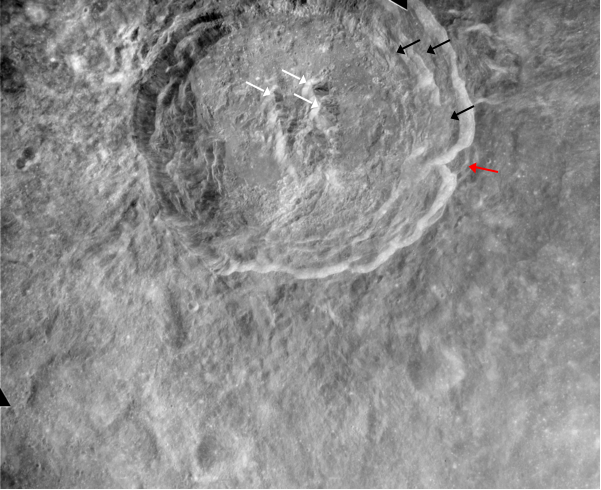
| Project Home | About the Scans | Browse Gallery | Image Map | Support Data | Resources | Ephemeris |
Featured Image - 18/11/2008
King Crater: excavating the lunar farside
The impact crater King, shown in the Apollo 16 image AS16-M-0078, is located on the far side of the Moon and is therefore inaccessible to Earth-based observations. King is 75 kilometers in diameter and about 4 kilometers deep. King is a good example of a young (complex) Copernican crater with a central peak in the crater floor, concentric terraces along the rim and walls, impact melt, and a large amount of impact ejecta. King actually has a cluster of central peaks. Slumping of material in the crater wall and interior rim formed the concentric terraces. After a large impact, the heat and pressure causes large amounts of rock to liquefy and form an impact melt, a mixture of melted rock and bits of impact debris trapped in the liquid. Impact melt pooled in the bottom of King crater, forming the relatively smooth floor. Impact melt also was blown out of the crater during the impact, and solidified beyond the crater rim (to the north, out of the image frame). Terraces do not form until the later stages of crater formation. The whole cratering process only takes a few seconds from impact to formation of the final crater. Large, young farside impacts excavate sections of the lunar crust. The Lunar Reconnaissance Orbiter Camera will provide even higher resolution UV-VIS data of similar areas, which will aid in our understanding of the crust, as well as other features.
Figure 1. Apollo 16 metric photograph depicting King Crater. The indentation on the southeast rim (red arrow) is a massive landslide. Large terraces on the eastern section of the rim are indicated by black arrows. The white arrows point to the central peaks. Overall, the rim is irregular -- unlike the smooth bowl shapes of small craters -- due to slumping and infill of the large crater basin that results in terracing. The ejecta blanket extends for two crater diameters, but is a little difficult to see due to the high Sun illumination. (Apollo Image AS16-M-0078 [NASA/JSC/Arizona State University])
Sources:
Apollo Over the Moon: A View From Orbit (1978) H. Masursky, G.W. Colton, F. El-Baz, eds. NASA Sp-362. http://www.hq.nasa.gov/office/pao/History/SP-362/contents.htm
Impact Cratering: a Geologic Process (1989) H.J. Melosh. Oxford University Press.

|
|
Space Exploration Resources |
|
 LPI LPI
|
